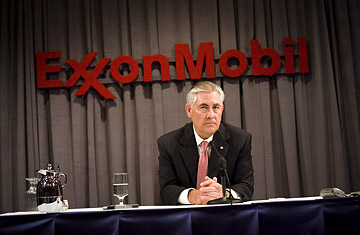
ExxonMobil chairman Rex Tillerson speaks after the company's annual shareholders' meeting on Thursday in Dallas.
As chairman and CEO of Exxon Mobil, Rex Tillerson can arguably claim to have played a key role in delivering a record $40.6 billion in profit to shareholders last year. Yet many of them, including dozens of descendants of John D. Rockefeller, whose Standard Oil morphed into Exxon, don't want him to be chairman anymore. At the oil giant's annual meeting in Dallas on Wednesday, nearly 40% of shareholders voted to separate the roles of CEO and chairman atop the oil giant. It was more support than most such proposals get, yet still far shy of a majority — a clear sign that even with high-profile support, shareholder activists are still fighting an uphill battle in trying to convince U.S. investors and corporations that independent chairmen act as counterweights to CEOs and help to create better-run companies.
It was, in fact, the sixth year in a row that shareholder activist Robert Monks, representing clients at his investment advisory firm, presented the resolution at the Exxon annual meeting. Over the years, the percentage of shareholders voting with Monks has increased from about 20% to 40% last year. With the backing of the Rockefeller family, hopes were high for a better showing this year, even though only 10 such proposals have ever managed to garner majority support, according to RiskMetrics, a firm that advises proxy voting. If the vote had reached a majority, it wouldn't have forced Exxon to separate the positions (like most such proposals, it was non-binding), but it would have sent a strong signal to management.
This year, investors filed nearly three dozen proposals for independent chairmen, at companies like Pfizer, Citigroup, Verizon, General Electric, Coca-Cola and Time Warner (parent company of TIME). So far those votes have only garnered an average 32% support, though some annual meetings remain. "Many of the problems surrounding poor governance stem from management accruing too much power," says Paul Hodgson, senior research associate at The Corporate Library, a governance and compensation research firm. "If you split the roles of CEO and chairman, you get this balance of power in the boardroom. A strong chairman can stand up to the CEO."
Most U.S. companies have a different perspective, arguing that a chairman-CEO is better positioned to take decisive action and carry out a successful vision. But according to RiskMetrics, 45% of S&P 1,500 companies (the nation's 1,500 largest by revenue) had a separate chairman and CEO in 2007. That number is up markedly since 2003, in the wake of the explosion of corporate accounting scandals, when only 30% of companies had different people in those roles. In many of those cases, however, the separate chairman happens to be a former CEO. Only 17% of S&P 1,500 companies (such as Disney and Borders) have truly independent chairmen — those not otherwise employed by the company — a figure that's up from 9% in 2003.
By so often concentrating corporate power in one person, the U.S. takes a very different approach from much of the rest of the world. Almost all companies in Germany, the Netherlands, the United Kingdom, South Africa and Australia split the CEO and chairman roles, sometimes because of the law, and sometimes because of other conventions. Companies listed on the London Stock Exchange, for example, are allowed to have the same person serving as both CEO and chairman — but they must provide a compelling reason why. As a result, some 95% of British companies split the job. Simon Wong, who studied the topic as a consultant at McKinsey, points to another reason why separating the roles is a tough sell in the U.S. "If you do not occupy both positions you are perceived to be not a sufficiently strong leader," says Wong. "That's a very U.S. perspective."
In the U.S., when companies do voluntarily split the CEO and chairman roles, it is frequently in response to poor performance or shareholder pressure — even if the decision is framed as a broader commitment to good corporate governance. In early May, Wachovia, which like many banks has been severely battered by the credit market meltdown, took its chairmanship away from CEO Ken Thompson and gave it to long-time director Lanty Smith. In a statement, Wachovia said it "recognized the importance of strong independent leadership," but Thompson also pointed out that the move would free him "to focus 100% of my time and attention on guiding the company through the current environment."
One result of separating the roles because of circumstance, rather than solely on principle, means that when circumstances change, so might the commitment to having different people in those jobs. In 2003, Charles Schwab stepped down as CEO of the brokerage firm he founded, but remained chairman. At the time, he said in the statement: "As many experts have suggested, from regulators to Congress to independent blue ribbon panels, it is important in today's environment that the positions of C.E.O. and chairman be distinct and that the chairman play a central role." But the next year, as the company struggled with competitors and new businesses, Schwab took back his former position. He currently serves as both CEO and chairman.
